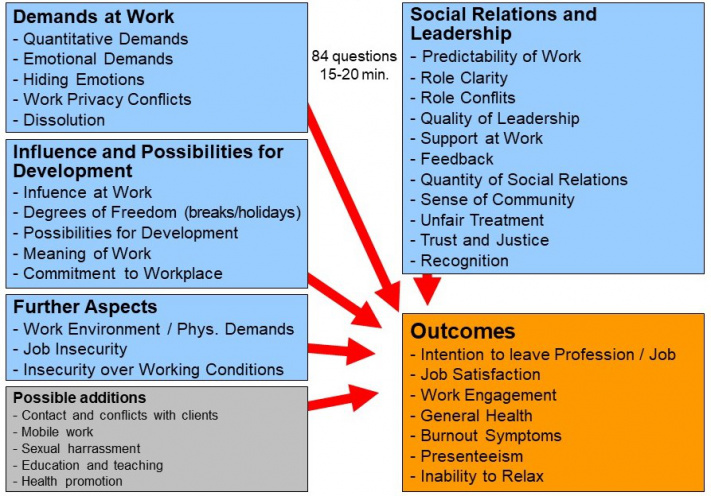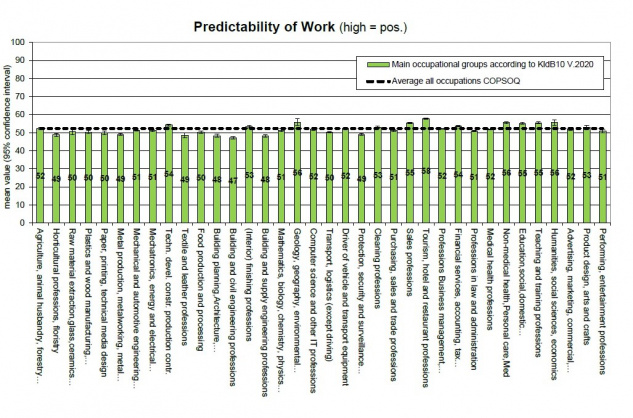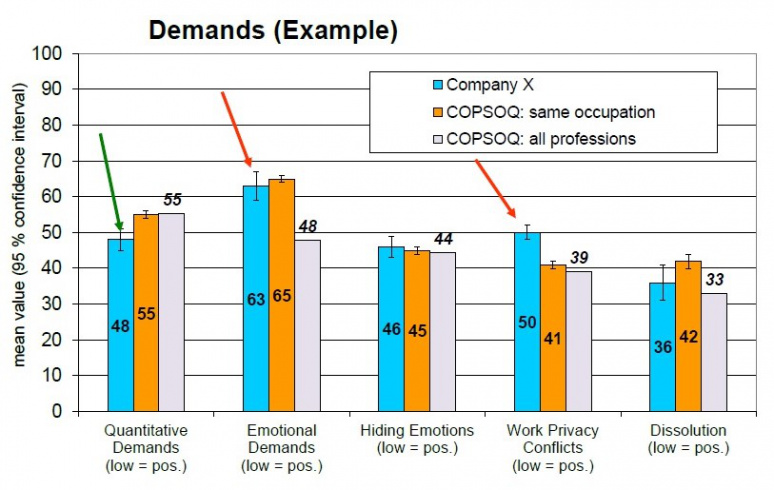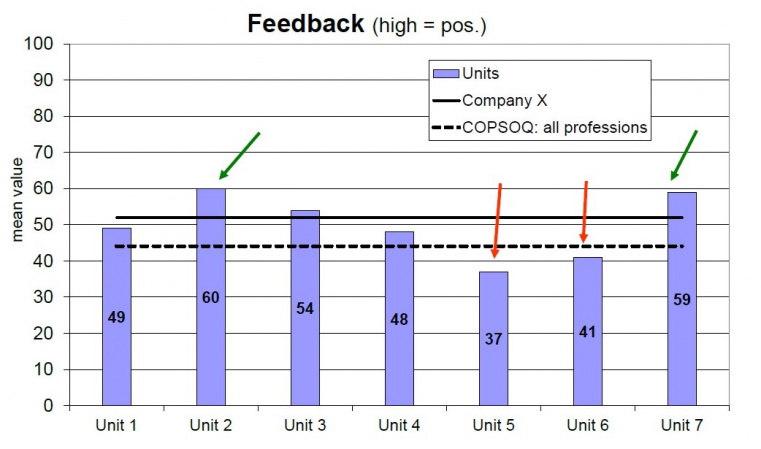What is COPSOQ?
The questionnaire on psychosocial factors in the workplace
The COPSOQ (Copenhagen Psychosocial Questionnaire) is a cross-sector and cross-occupational questionnaire. It is based on the scientific model of a cause-effect relationship between psychological working conditions (stressors) and reactions of working people (consequences of stress or strains).
On request, we can supplement the standard version of the COPSOQ with question modules on "contact and conflicts with clients (patients, citizens, etc.)", "sexual harassment at the workplace", working in a "mobile work", "education and teaching" and "workplace health promotion offers".
In general, the questionnaire also contains information on the company (locations, departments) and employment relationship (occupation, position, working hours) as well as sociodemographic characteristics (age groups, gender).

Based on a solid scientific foundation
The COPSOQ was developed at the National Institute of Occupational Health in Copenhagen. In Germany, the questionnaire was first tested in 2005 on behalf of the Federal Institute for Occupational Safety and Health (Bundesanstalt für Arbeitsschutz und Arbeitsmedizin). The trial study by Nübling et al. showed good suitability of the COPSOQ as a screening instrument. This leads to the recommendation of the questionnaire for the assessment of psychosocial stresses and strains at work:
The goal of providing a valid and reliable instrument for measuring mental stress and strain at work is thus achieved. This was also the conclusion of the new validation study of the questionnaire from 2021, among others:
To date, over 630,000 employees have completed the COPSOQ in Germany alone.
Scientific award
In 2018, we were awarded the Julius Springer Prize of the Central Journal of Occupational Medicine, Occupational Safety and Ergonomics (Zentralblatts für Arbeitsmedizin, Arbeitsschutz und Ergonomie). At the 58th annual conference of the German Society for Occupational and Environmental Medicine (Deutschen Gesellschaft für Arbeitsmedizin und Umweltmedizin), we were awarded the prize for a paper on the (in)dependencies of psychological workload on the profession performed:
All publications
Our grounding in science is shown by our publications. The publications from the COPSOQ team of the FFAW are listed here. The spectrum of international work on COPSOQ includes occupational medicine, organizational psychology, sociology and methodological issues. You will find the international publications on COPSOQ here.
Global and multilingual
COPSOQ has been international from the very beginning. The cooperative relationships of regional COPSOQ teams are bundled in the activities of the international COPSOQ network: information on this network can be found here. Given the global importance of the questionnaire, the international research community has defined a core set of COPSOQ questions and the conditions of use of the questionnaire. We are significantly involved in this development:
The variety of languages associated with the COPSOQ offers a number of practical advantages. Multinational companies are able to conduct the survey in the respective national languages of their locations. Furthermore, for surveys in German-speaking countries, employees from other countries can complete the questionnaire in their native language. Currently, the survey can be carried out in 28 different languages, including all EU languages and other languages. A selection of these languages is provided below:
 Furthermore, we are pleased to offer COPSOQ in the language of your choice.
Furthermore, we are pleased to offer COPSOQ in the language of your choice.
Survey in accordance with the joint German occupational safety and health strategy
In Germany, the analysis of mental stress is part of the legally required risk assessment (ArbSchG §5ff). In Austria, this is the workplace evaluation (ASchG §§ 4,5). The employer is responsible for planning and implementing the risk assessment.
The Joint German Occupational Health and Safety Strategy (Gemeinsame Deutsche Arbeitsschutzstrategie) is an initiative of the Federal and National Government, statutory accident insurers and the social partners, which has adopted quality principles for the risk assessment of mental stress and issued recommendations for its implementation. The COPSOQ measures mental stress in the sense of the Joint German Occupational Health and Safety Strategy.
COPSOQ results: Measuring is Comparing
COPSOQ results: Measuring is Comparing
The necessity of improvement measures does not result directly from the results of a survey, but from the comparison with results from as many other surveys as possible. This is what makes the survey on mental stress a measurement. We therefore prefer the empirically based evaluation of results to orientation on values that are based on purely theoretical considerations.
The reference values from the COPSOQ database of the Freiburg Research Centre for Occupational Sciences (FFAW) serve this purpose. Since the COPSOQ is suitable for all fields of activity, the database today includes the anonymised data of more than 630,000 respondents. A central comparative value for us is the representatively weighted average value for all occupational groups in Germany.
The diagram shows by example the measured values of the COPSOQ scale "Predictability of Work" for different occupations (bars) - sorted according to the current official classification (KldB 2010 V.2020) at the 2-digit level - and for the totality of occupations (dashed line). The predictability of work is a factor that depends more on the quality of operational planning (organisation) than on the content of the activity (occupation). We have described elsewhere how this relates to the other factors:

The result in external comparison
Only the comparison shows whether one's own result is rather favorable or unfavorable, and whether it corresponds, for example, to values typical for the profession or for the industry. The example diagram shows the comparison with values from the COPSOQ database for a fictitious company X.
The quantitative demands are low (green arrow), both in comparison with respondents from the same field of activity (occupational group) and in comparison with employees in Germany as a whole. In contrast, the emotional demands are higher - measured against the cross-section of all occupations (red arrow). Looking at the same occupational group, however, an increased value does not seem unusual.
The hiding of emotions does not deviate strikingly from the other comparison groups. The same applies to the scale dissolution. The reconciliation of work and private life (work privacy conflicts) is a different matter. The fictitious company seems to manage this less well than in Germany as a whole and among respondents in comparable occupations (red arrow).
In the overall view of the requirements, there is thus a need for action in terms of risk assessment primarily with regard to the compatibility of work and private life and then with regard to emotional demands.

Group differences in internal comparison
If different groups of employees (departments, units, activity groups, etc.) are defined in the questionnaire, the internal comparison can reveal deviations from the overall result. The example chart for the fictitious company X reveals significant differences between its departments in terms of feedback.
Employees in units 2 and 7 (green arrows) receive significantly more feedback on the quality of their work than, for example, their colleagues in units 5 and 6 (red arrows). Accordingly, the primary aim should be to find reasons for the sparse feedback in departments 5 and 6 and to initiate improvements.

Report and development of action
A maximum of 4 weeks after the survey, we will send you the results report with internal and external comparison. To ensure anonymity, only results for groups of at least 5 respondents (more if desired) will be reported.
The report for your organization consists of the following parts:
- Text section with background information and interpretation of your results
- Documentation of the COPSOQ questionnaire (in the form used by you)
- Tabular results for all scales and items (questions) incl. free texts
- Graphs on the overall results with external comparison (identical occupational groups from the COPSOQ database)
- Internal comparison for graphical comparison of predefined groups or organizational units.
for all scales and items (questions)
First of all, it is important to discuss the results within the company (e.g. in a task force) in order to determine areas for action.
Taking into account objectives and resources, improvements can often be achieved with "onboard resources" (e.g. team discussions). In many companies, experts (e.g. company doctor, occupational safety specialist) are already active. In addition, we can provide further support on request, e.g. from occupational and organizational psychologists, health consultants or coaches who are well acquainted with COPSOQ.
Evaluation
In the course of a repeat survey - recommended after 1-2 years - changes in stress over time can be examined and the effects of improvement measures can be reflected upon (evaluation).
The comparison of the results of different survey dates is automatically included in the follow-up survey. Measurement at regular intervals fits in with dynamic concepts of workplace health management and the "learning organisation".
The repeat survey finally fulfils the purpose of the occupational risk assessment (ORA) as a process of methodically controlled improvement of mental stress.

